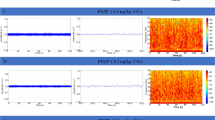Abstract
Male Wistar rats were subjected to repeated weekly episodes of 2 days severe alcohol intoxication (intragastric intubation) and 5 days of withdrawal. In half of the animals the withdrawal reaction was attenuated during the first nine weekly episodes by intragastric intubations with phenobarbital. During episodes 10–14 both phenobarbital treated and phenobarbital untreated animals were allowed to develop a withdrawal reaction; all animals were video-recorded during withdrawal and the records were rated blindly for the occurrence of convulsive seizures. The results were analyzed by stepwise logistic analysis of regression including phenobarbital treatment, alcohol dose and intoxication score as explanatory variables for the occurrence of convulsive seizures. The animals that had been in withdrawal during all episodes developed significantly more convulsive seizures compared with animals that had their first nine withdrawal episodes attenuated by phenobarbital. The development of withdrawal seizures depended on repeated episodes of withdrawal, whereas repeated alcohol intoxication per se did not explain the development of seizures. There were no differences between the groups in the severity of the non-convulsive signs of alcohol withdrawal. Thus the development of seizures and the non-convulsive signs of alcohol withdrawal may result from two pathogenetically different mechanisms: 1) seizures from a cumulative kindling-like effect over long time periods and 2) physical signs of alcohol withdrawal may reflect the degree of physical dependence during the most recent drinking bout.
Similar content being viewed by others
References
Baker TB, Cannon DS (1979) Potentiation of ethanol withdrawal by prior dependence. Psychopharmacology 60:105–110
Ballenger JC, Post RM (1978) Kindling as a model for alcoholic withdrawal syndromes. Br J Psychiatry 133:1–14
Brown ME, Anton RF, Malcolm R, Ballenger JC (1988) Alcohol detoxification and withdrawal seizures: clinical support for a kindling hypothesis. Biol Psychiatry 23:507–514
Clemmesen L, Hemmingsen R (1984) Physical dependence on ethanol during multiple intoxication and withdrawal episodes in the rat: evidence of a potentiation. Acta Pharmacol Toxicol 55:345–350
Goddard GV, McIntyre DD, Leech CK (1969) A permanent change in brain function resulting from daily electrical stimulation. Exp Neurol 25:295–330
Grove WM, Andreasen NC (1982) Simultaneous tests of many hypotheses in explanatory research. J Nerv Ment Dis 170:3–8
Hemmingsen R (1989) Kindling, psychopathology and cerebral mechanisms in ethanol withdrawal. In: Bolwig TG, Trimble MR (eds). John Wiley, Chicester pp 137–145
Hemmingsen R, Chapman AG (1980) Cerebral metabolic state during the ethanol withdrawal reaction in the rat. J Neurochem 34:1561–1566
Hemmingsen R, Kramp P (1988) Delirium tremens and related clinical states: psychophathology, cerebral pathophysiology and psychochemistry: A two-component hypothesis concerning etiology and pathogenesis. Acta Psychiatr Scand Suppl 345[78]:94–107
Hemmingsen R, Kramp P, Rafaelsen OJ (1979) Delirium tremens and related clinical states: aetiology, pathophysiology and treatment. Acta Psychiatr Scand 59:337–369
Isbell H, Fraser HF, Wikler A, Belleville RE, Eisenmann AG (1955) An experimental study of the etiology of “rum fits” and delirium tremens. Q J Stud Alcohol 16:1–33
Kramp P, Hemmingsen R (1979) Delirium tremens. Some clinical features. Part I. Acta Psychiatr Scand 60:393–404
Kramp P, Rafaelsen OJ (1978) Delirium tremens: a double-blind comparison of diazepam and barbital treatment. Acta Psychatr Scand 58:174–190
Majchrowicz E (1975) Induction of physical dependence upon ethanol and the associated behavioral changes in the rat. Psychopharmacologica 43:245–254
Majchrowicz E, Hunt WA (1976) Temporal relationship of the induction of tolerance and physical dependence of continuous intoxication with maximum tolerable doses of ethanol in rats. Psychopharmacology 50:107–112
McCullagh P, Nelder JA (1983) Generalized linear models. Chapman & Hall, London pp 72–100
Racine RJ (1972) Modification of seizure activity by electrical stimulation II. Motor seizure. Electroencephalogr Clin Neurophysiol 32:281–294
Schmutz M, Klebs K (1989) Kindling and antiepileptic drugs. In: Trimble MR, Bolwig TG (eds) The clinical relevance of kindling. John Wiley, Chicester, pp 55–68
Ulrichsen J, Clemmesen L, Flachs H, Hemmingsen R (1986) The effect of phenobarbital and carbamazepine on the ethanol withdrawal reaction in the rat. Psychophrmacology 89:102–106
Victor MM, Adams RD (1953) The effects of alcohol on the nervous system. Research Publications — Association for Research in Nervous and Mental Disease 32:526–573
Wulff MH (1959) The barbiturate withdrawal syndrome. A clinical and electroencephalographic study. Clin Neurophysiol Suppl 14:1–173
Author information
Authors and Affiliations
Rights and permissions
About this article
Cite this article
Ulrichsen, J., Clemmesen, L. & Hemmingsen, R. Convulsive behaviour during alcohol dependence: discrimination between the role of intoxication and withdrawal. Psychopharmacology 107, 97–102 (1992). https://doi.org/10.1007/BF02244972
Received:
Revised:
Issue Date:
DOI: https://doi.org/10.1007/BF02244972



